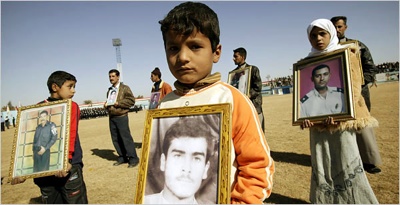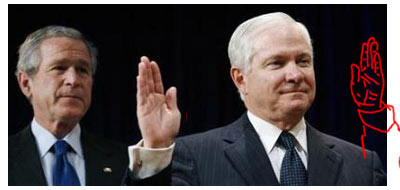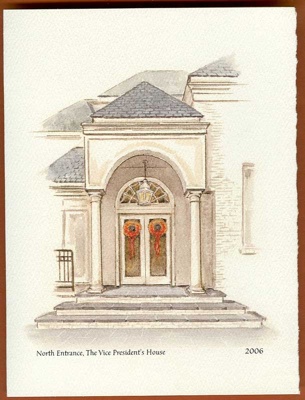Notes
Najaf
(As a near end of the year note, I wanted to properly introduce, and formally recognize Chris Maynard for his valuable contribution to this site. As a professional photographer, Chris lends a practiced eye to this new genre of photo analysis and interpretation. From 1993 to 2005, Chris freelanced for The New York Times, and spent some of that time doing photo editing. He has been sharing this space with me since October, and I wish to officially, if belatedly, welcome him, and thank him for all his effort and insight. — Michael Shaw)
by Chris Maynard
Earlier this week, Iraqi forces took control of the province of Najaf, south of Baghdad, marking the first time the United States has turned over that responsibility to national troops. (Two other provinces have already been given over by Britain and Italy.) Although the public was not permitted to watch, they put on a parade for military and foreign guests, complete with the flowers we heard about back in March of 2003. This time they were plastic, and affixed to new military vehicles instead off being joyously strewn before the liberators. All roads in the city were closed before the festivities began.
As dog and pony shows go, it seemed like a good one. Inside a local stadium, commandos demonstrated their karate moves and kicks, and a police officer in plain clothes acting as a terrorist was taken down by, naturally, an Iraqi anti-terrorist squad.
The highlight seemed to be the moment when members of a group of the commandos pulled live frogs from their pockets and bit their heads off, followed by another soldier who sliced open the stomach of a live rabbit and proceeded to take bites of the organs. The lapin du jour was then passed around the squad. (This seemed to be a throwback to the days of Saddam Hussein, when his road and television shows sometime included the same demonstration, with the addition of snakes, cats and dogs. Popular taste transcends political boundaries.)
Off to itself on one side was a small group of civilians, holding framed photographs of deceased family members who had been police officers. As American policy continues its deadly game of “Who’s on First?”, we see very few pictures of the families of Iraqi uniformed casualties. Here they are mute, bystanders seemingly making no demands except perhaps “Please remember us.”
When Mr. Bush and Mr. Rumsfeld made their publicity trips to Iraq they basically stayed for lunch and then left. Given their responsibility for the Iraqi deaths as much as for the American forces one might think they’d want to stop in at a local field hospital to press some flesh, even if there were no votes available. They didn’t. Perhaps they were never really sure themselves who was fighting whom. The relatives in this picture probably also have no idea who killed their loved ones, but they do know they didn’t start the battle. Their sadness lies in their utter helplessness.
It’s hard to recall any photo at all of Iraqi forces after their initial wounding or death. Their families obviously don’t disappear. In this case, we have no idea why they showed up for this ceremony at all. Since it’s a closed audience, they’re not being used as tools, like sitting next to the First Lady at the State of the Union address. There are no signs, no buttons, no sashes. Although news stories usually don’t give them more than a brief mention, there have to be an awful lot of them.
Lost fathers, husbands, brothers, sons. It’s hard being a footnote.
(image: Christoph Bangert for The New York Times. December 2006. Najaf. nytimes.com)



Reactions
Comments Powered by Disqus